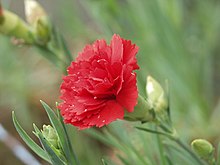| Dianthus caryophyllus | |
|---|---|

| |
| Red carnations | |
| Scientific classification | |
| Kingdom: | Plantae |
| Clade: | Tracheophytes |
| Clade: | Angiosperms |
| Clade: | Eudicots |
| Order: | Caryophyllales |
| Family: | Caryophyllaceae |
| Genus: | Dianthus |
| Species: | D. caryophyllus
|
| Binomial name | |
| Dianthus caryophyllus | |
Dianthus caryophyllus (/daɪˈænθəs ˌkɛəriəˈfɪləs/ dy-AN-thəs KAIR-ee-ə-FIL-əs),[1][2] commonly known as carnation or clove pink, is a species of Dianthus native to the Mediterranean region. Its exact natural range is uncertain due to extensive cultivation over the last 2,000 years. Carnations are prized for their vibrant colors, delicate fringed petals, and enchanting fragrance.
The scent of carnations is often described as spicy, clove-like, or reminiscent of a combination of cinnamon and nutmeg, hence the common name "clove pink". This delightful aroma has made carnations a popular choice for use in perfumes, potpourri, and scented products.
They have cultural significance and are associated with love, distinction, and motherly affection. With numerous cultivars and hybrids, carnations offer a wide variety of colors and forms, making them popular for gardens, floral arrangements, and scented products. Overall, carnations are enduring symbols of beauty and grace, treasured by flower enthusiasts and used to convey heartfelt emotions.[3][4][5]
- ^ "dianthus". Merriam-Webster.com Dictionary. Merriam-Webster.
- ^ "Caryophyllus". Merriam-Webster.com Dictionary. Merriam-Webster.
- ^ Flora Europaea: Dianthus caryophyllus
- ^ Blamey, M. & Grey-Wilson, C. (1989). Flora of Britain and Northern Europe. ISBN 0-340-40170-2
- ^ Huxley, A., ed. (1992). New RHS Dictionary of Gardening. Macmillan ISBN 0-333-47494-5.